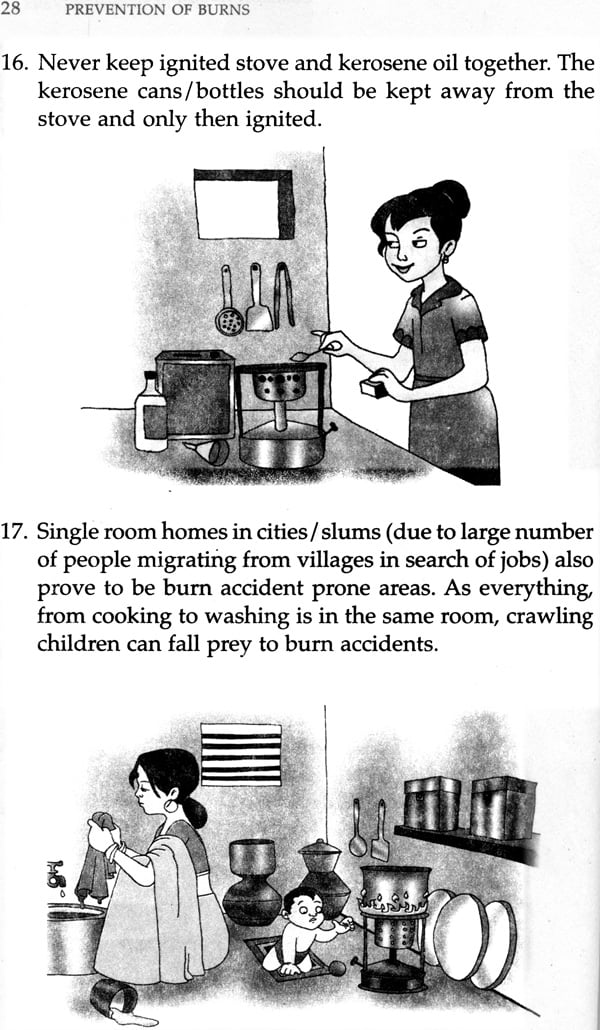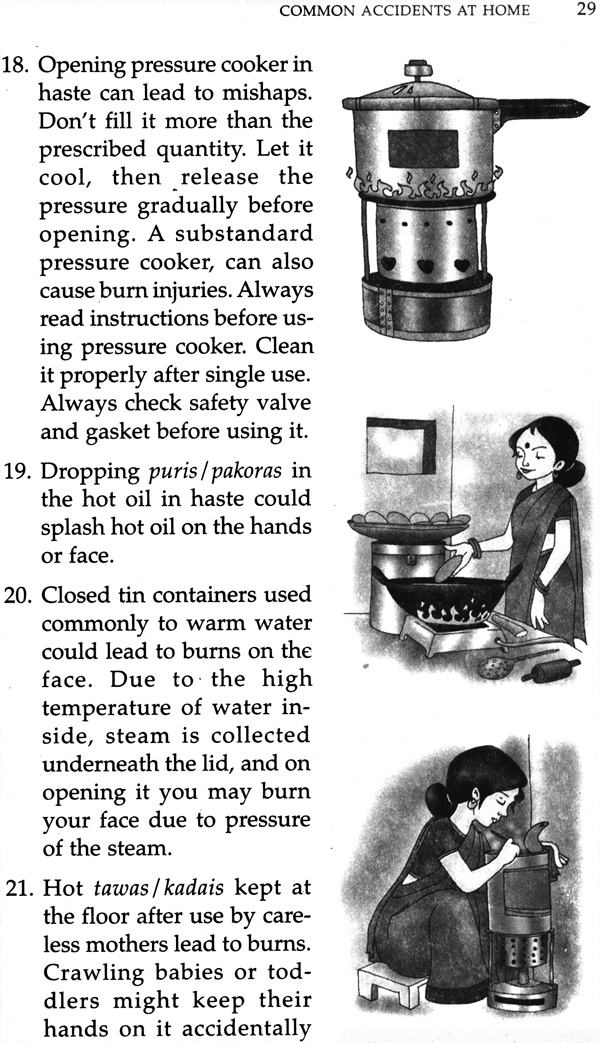
Prevention of Burns (A Handbook on Prevention of Burn Injuries)
Book Specification
| Item Code: | NAK174 |
| Author: | Kalpana Sood Lal |
| Publisher: | National Book Trust, India |
| Language: | English |
| Edition: | 2005 |
| ISBN: | 9788123745756 |
| Pages: | 75 |
| Cover: | Paperback |
| Other Details | 8.5 inch x 5.5 inch |
| Weight | 120 gm |
Book Description
In India almost 30 lakh people suffer burns annually, of whom nearly 10 lakh die and an equal number are crippled. Eighty per cent of these burns affect women and young children in the prime of their lives. Treatment of burns is expensive, prolonged and not readily available through the country. Much of this can be prevented by exercising small precautions in our day to day life, which can go a long way in saving many lives. This book is a step towards the same direction and aims to spread awareness among people that for burns, prevention and precaution are better than cure.
Dr. Kalpana sood Laal acquired her doctorate from Dev Raj Urs Medical College, Kolar, Bangalore University in 1992. She served Himachal Government as Medical Officer, and subsequently joined Haryana Government service. Dr. Lal is presently on deputation to the Central Government Health Seheme (CGHS). She is keenly interested in promoting maternal and child health through education and counselling.
It is really a pleasure for me to write a few lines about this book as the President on national Academy of Burns, India. It is an extremely hard task to manage burns when facilities are dismal.
No amount of safety precautions can completely eliminate burns, but little care and for thought may reduce the incidence. It is, thus agreed that a large Percentage of burns, both domestic and industrial, are preventable by simple modifications of machines, environments and education.
This book depicts the hazardous results following burn injuries and provides solutions in the form of prevention. On going through the book, I find that it is equally good for the education of the mothers at home who are more prone to burn injuries in kitchen. They can learn how to avoid accidents at home especially with cooking gas, stove and chulha. The children, responsible citizens of tomorrow will come up with a positive attitude towards prevention of burns. Their generation will lead a fire free hazard life.
I am confident that this book has been written with the aim to impart Practical knowledge to the readers. I recommend this book to be placed in school, colleges, NGOs and public libraries. I congratulate Dr. Kalpana Sood Lal who has put her head, heart and hands in compiling this book.
Until the 19th century, infections claimed the lives of large number of people since there was little knowledge about diseases, their cause and cure. Antibiotics changed this scenario after the discovery of penicillin by Sir Alexander Fleming in 1928. As man overcame one disease after the other due to better understanding of micro organism, the longevity of life increased. Thus, infections were replaced by diseases of old age. As technology developed, people found their own inventions as the major cause of injury and death. A large number of people become victims of accidental deaths, especially in the prime of their lives.
Various types of accidents could include high speed road crashes, train of air accidents, fall for high rise buildings industrial accidents and burn injuries. A large fragment of the population in our country is a silent victim of burn injuries caused as a result of overlooking simple preventive stems that could have avoided the happenings in the first place.
We need to analyse the burn injuries from a holistic point of view to understand the mechanism of its control. More than 80 percent of the burn injuries occur as a result of accidents at home, the majority of which occur in the kitchen. An estimated 30-40 lakh people receive burns annually in our country and shocking, almost one third of them die and one fight are left with severe deformity, disfigurement and disability that haunts them for the whole of their remaining lives. Also burns treatment is very expensive and there are very limited centres in the country which can treat major burn injuries.
Preventive steps in the form of intensive education, programmes for burn prevention, and enforcement of legislation has almost eradicated burns in the western countries. It is surprising to know that burn treating hospitals and departments have been shut down in many countries since there are no burn cases.
The redeeming feature about burns however, is that injuries unlike other diseases are completely preventable. But how can one prevent a disaster if one does not know the methods of prevention? While there are vaccines for prevention of communicable diseases, there is only one vaccine for prevention of burns and that is through education. This book is a step in this direction and it is hoped that all of you who go through this book would make your home, workplace and your neighbourhood safe from likely burn injuries. Let us all make our country a sage place to live in and let the light of knowledge dispel the dark clouds of ignorance.
Thousands of years ago, the Cave man accidentally discovered fire and used it for it for his day to day living. He realised that two pieces of hard stones when rubbed together produced sparks. If the sparks fell on dried leaves, they burst into flames. Then early man saw wild creatures running away from forest fires, so he used fire to protect himself from strong wild animals. Fire was lighted outside the caves at night to keep away the wild animals. Discovery of fire also changed the eating habits of early man. He found the roasted meat tastier. This was also the beginning of cooked food. Little did he realise at that time this friend of this of his could also turn out to be his enemy, if handled carelessly.
Burns due to fire are among the earliest known injuries in the history and find a mention even in the Egyptian Ebers papyrus, which describes a five day course treatment Hippocrates (5th century BC) emphasised on wound cleaning and avoiding of infection. Rhazes (AD 850-923) prescribed rose water cooled by snow and Avicenna (AD 980-1037) prescribed the value of cold water for the treatment of burns. After AD 1800 there were rapid advances in the treatment modalities for burns, with the discovery of skin grafting and better understanding of hte physiology of burns.
It has been found that all these years, burns have mostly been caused due to careless accidents. Burn accidents remain the most common type of accidents in our day to day life.
Burn injuries mostly affect children and women. It is surprising to know that approximately 30 lakh people get burnt every year in our country. Out of these about 10 lakh die. Those who survive without treatment get badly disfigured, deformed and become a social stigma for the rest of their lives and unfortunately, a burden to their family and society. It is indeed frightening to know that such a large number of people most of whom are school children and mothers, suffer due to fire.
Burns are caused due to accidents. The meaning of the word 'accident' in the dictionary is, 'An unpleasant incident that happens unexpectedly'. The meaning of the word prevention is, 'To stop something from happening. The word precaution means, 'something done in advance to avoid problems or danger'. Thus, it is easy to understand that accidents can be prevented if proper precautions are taken.
If we follow the instructions regarding safe handling of fire – prone articles or objects or procedures around us, we can save ourselves and the people around us from an accident.
In medical sciences, most diseases can be cured by medicines or by surgery. Burn injuries due to fire are also treated, but unfortunately the results of treatment may not give back the original shape or colour. Sometimes, when burns involve a large part of the body, most people die. A large majority of burns patients are left with severe disfigurement to the face or other body parts. At times, a particular part of the body is rendered useless for the rest of the life.
Burns also have severe psychological and social impact on the victim. The near and dear ones react in varied ways, treating them as a burden. The parents are often under severe economic stress. Some openly reject a disfigured child. Children with burns are also anxiety to the parents for the prospects of marriage. Sometimes the siblings and peer groups isolate burn victims due to their disfigurement and ugly scars.
Hence, one has to pay a bigger price to pay for something that could have been easily prevented. Thus, saying that 'Precaution and prevention is better than Cure' is applicable to a patient with burn injuries.
| Foreword | vii | |
| Acknowledgements | ix | |
| Preface | xi | |
| 1 | Introduction | 1 |
| 2 | Types of Burns | 4 |
| 3 | Skin and its Functions | 10 |
| 4 | How to Assess the Severity of Burns | 15 |
| 5 | Who gets Burns? | 19 |
| 6 | Common Accidents at Home | 22 |
| 7 | First Aid Guide | 37 |
| 8 | The Right way to Celebrate Diwali | 41 |
| 9 | Disasters | 47 |
| 10 | Safeguarding Children and Making Self Schools | 51 |
| 11 | National programme for Prevention of Burn Injuries | 53 |
| 12 | Delhi Fire Prevention and Safety Act, 1986 & fire Precautions Advised | 63 |







